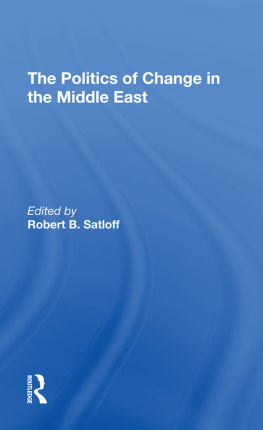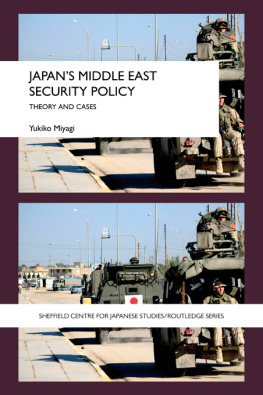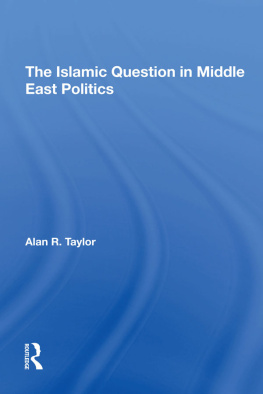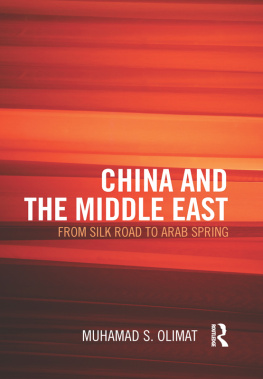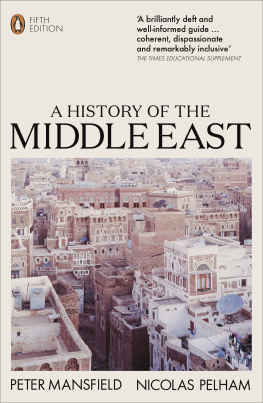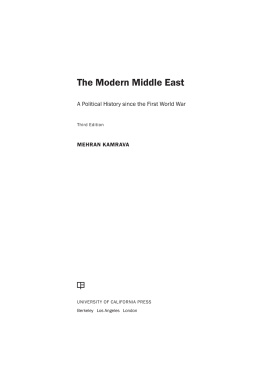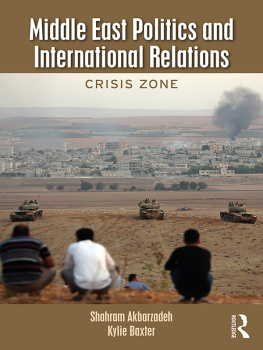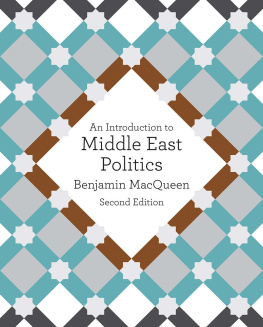Routledge Library Editions: War and Security in the Middle East
Volume 1
CONFLICT IN THE MIDDLE EAST
Conflict in the Middle East
P. J. Vatikiotis
First published in 1971 by George Allen & Unwin Ltd
This edition first published in 2017
by Routledge
2 Park Square, Milton Park, Abingdon, Oxon OX14 4RN
and by Routledge
711 Third Avenue, New York, NY 10017
Routledge is an imprint of the Taylor & Francis Group, an informa business
1971 Aldine Atherton
All rights reserved. No part of this book may be reprinted or reproduced or utilised in any form or by any electronic, mechanical, or other means, now known or hereafter invented, including photocopying and recording, or in any information storage or retrieval system, without permission in writing from the publishers.
Trademark notice : Product or corporate names may be trademarks or registered trademarks, and are used only for identification and explanation without intent to infringe.
British Library Cataloguing in Publication Data
A catalogue record for this book is available from the British Library
ISBN: 978-1-138-19428-1 (Set)
ISBN: 978-1-315-54183-9 (Set) (ebk)
ISBN: 978-1-138-19500-4 (Volume 1) (hbk)
ISBN: 978-1-315-61689-6 (Volume 1) (ebk)
Publishers Note
The Publisher has gone to great lengths to ensure the quality of this reprint but points out that some imperfections in the original copies may be apparent.
Disclaimer
The publisher has made every effort to trace copyright holders and would welcome correspondence from those they have been unable to trace.
CONFLICT IN THE MIDDLE EAST
P. J. Vatikiotis
First published in 1971
This book is copyright under the Berne Convention, All rights are reserved. Apart from any fair dealing for the purpose of private study, research, criticism or review, as permitted under the Copyright Act, 1956, no part of this publication may be reproduced, stored in a retrieval system, or transmitted, in any form or by any means, electronic, electrical, chemical, mechanical, optical, photocopying, recording or otherwise, without the prior permission of the copyright owner. Enquiries should be addressed to the publishers.
Aldine Atherton, 1971
ISBN 0 04 327036 0
Printed in Great Britain
in 11 point Plantin type
by The Aldine Press, Letchworth, Herts
To my wife
It will be clear to the reader that I have indulged in a very broad survey of political conflict in the Middle East. Much of the orientation of this survey is shared by other students of the region. Although I have not cited widely or referred extensively to the works of scholars of the history and politics of the region or of history and politics generally, which have influenced my tableau of the area's problems, I need hardly emphasize the fact that these have been several, and I am indebted to all of them.
Albert Hourani of St Antony's College, Oxford, read my manuscript and offered challenging criticism and valuable comments. So did Professor Elie Kedourie of the LSE, and Professor Peter J. Fliess of the University of Massachusetts. I am grateful to them for their assistance, but they are in no way responsible for any of the views, judgments or errors in this book. I am also grateful to Dr E. R. J. Owen and his colleagues at the Middle East Centre, St Antony's College, Oxford, for giving me the opportunity to discuss the contents of this book in a series of talks to the Middle East Seminar during Trinity term, 1969-1970. Some of the analysis and views expressed in this book were influenced in part by the deliberations of a Graduate Seminar in Middle Eastern Politics conducted by Professor Malcolm Kerr at the University of California, Los Angeles, in the Spring term of 1969. I have moreover relied heavily on Professor Kerr's published and unpublished studies of the Arab-Israeli conflict and regional Arab politics. I have also had the benefit of the critical editorial advice of David Croom of George Allen & Unwin Ltd.
Finally, I wish to thank Mrs Sheila Sexton in the office of the Department of Economic & Political Studies, School of Oriental & African Studies, who typed the manuscript.

This essay is primarily a survey of political conflict in the Middle East. What it does not, and deliberately avoids to do, is to offer solutions to political problems. Many of these arise from the area's social and political structure and I see them as not being resolved in the near future. Rather I discuss certain aspects of politics in the Middle East which I consider important for a better understanding of the region.
My discussion is objective to the extent that its approach to politics in the Middle East derives from an observation and examination of the perception of politics Middle Easterners themselves appear to have; of how they view themselves in a political relationship with others. It is not objective, however, in the sense that it purports an unconcerned discussion of politics in that area. Nor in the sense that I have no position regarding recent events and upheavals there. This will become clear, I hope, in the course of the exposition, for this essay is also, in part, my response to what is going on in the Middle East.
The confusion over politics in the Middle East arises partly from the assumption that Middle Easterners have the same political desires as ourselves in fact, as all men everywhere. We have, for instance, facilely accepted changes in regimes, in the location and use of power as the imperative extension of Revolution in Europe without a proper consideration of the evidence. We have confused nationalism with nationality and patriotism, revolution with progress, stability with stagnation, instability with deviation from a presumed norm, ideological assimilation for state political purposes with the formulation of fundamental regulative principles, militant self-assertion with political maturity, mass mobilization with citizen participation in a civil polity.
In dealing with the sources, the forms, scope and levels of political conflict in the Middle East, I hope to suggest a more circumspect approach to the study of Middle Eastern societies, and to seek a more realistic perspective for the examination of political phenomena in them. My intention is to attempt to describe the reality of political conflict in the Middle East.
For the purposes of this essay, the Middle East will comprise a core area with peripheries. The core consists of the Arab lands of the Middle East, that is, the Fertile Crescent (Iraq, Syria, Lebanon and Jordan); the Arabian Peninsula, including Saudi Arabia, the Yemen, South Arabia (South Yemen), Muscat and Oman, the Trucial or Gulf States, Kuwait and Bahrain; Egypt strategically located astride east and west of the Arab Middle East. Even though one could argue that the Sudan forms a separate periphery, or appendage, one may include it in this core area for the sake of convenience.



